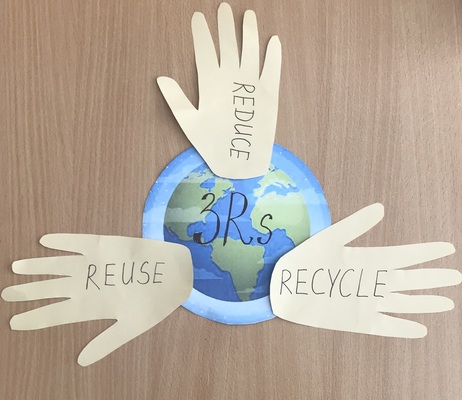CIVICS EDUCATION CLIL LESSONS 1
November 2019
Liceul Tehnologic Octavian Goga Jibou, Romania
Civics Education CLIL RO_1.docx
School: Liceul Tehnologic Octavian Goga Jibou, Romania
Age of students/Grade: 11 years old /5th grade
Level of English: A1
Teacher(s): Nagy Melinda
Subject(s): English / Civics Education
Topic: Good Students
Aims:
- To listen and read for specific information
- To read for key information
- To consolidate information in a text
Teaching points:
| Language | Content |
| • pay attention • realise • set a limit • waste • respect • polite • raise your hand • treat | - Being a good student
- “Respect yourself and others will respect you.”
- Planning your time
- Taking care of yourself
|
Resources: Videoprojector, laptop, tablets, handouts of the text, speakers
Description of the activities:
Activity 1: To listen and read for specific information
• Ss look at the picture and read the title of the text and the headings.
•Ss guess what they will read about.
•T plays the recording. Ss listen and read and find out.
Activity 2: To read for key information
• T gives Ss time to read the text again and match the headings to the paragraphs.
• T checks Ss’answers.
Activity 3: To consolidate information in a text
• T asks Ss to discuss in pairs how they think they are a good student and what things from the text they feel they have to work on.
• T asks various Ss to share their answers with the class.
Activity 4: Poster creation
- Ss work in groups of 4 and create a poster with the title “How to be a good student”
- Ss present their work
Supplementary materials (books, links, etc).
“Right On” – textbook for the 6th grade, Express Publishing, page 26
VILNIAUS SAUSIO 13-OSIOS PROGIMNAZIJA, LITHUANIA
CLIL Lesson Plan
Civics Education CLIL LT_3.docx
School: Vilniaus Sausio 13-osios progimnazija, Lithuania
Age of students/Grade: 11 years old /5th grade
Level of English: A1
Teacher(s): Šunina Žana
Subject(s): English / Civics Education
Topic: Our Precious Planet!
Aims:
- To learn topic-related vocabulary
- To listen and read for specific information
- To read for key information
- To consolidate information in a text
Teaching points:
| Language | Content |
| • drop litter • chemicals • rubbish • recycle • pollution • rainforest • take care of • cause • ocean • save electricity • campaign • must/mustn’t | - Water pollution
- Air pollution
- Destruction of forests
|
Resources: Videoprojector, laptop, handouts of the text, speakers
Description of the activities:
Activity 1: To learn topic-related vocabulary
• T points to pictures and says the appropriate words. Ss repeat chorally and individually.
Activity 2: To listen and read for specific information
• T plays the recording. Ss listen to the article and read it to choose the correct alternative to fill in the blanks in sentences 1-5 (ANNEX 1).
Activity 3: To read for key information
• T gives Ss time to read the text again and complete the table (ANNEX 2).
• T checks the answers.
• Ss use the table to talk about pollution.
Activity 4: To consolidate information in a text
• T asks Ss to discuss in pairs what must we do to keep our planet clean and healthy.
• T asks various Ss to share their answers with the class.
Activity 5: Poster creation
- Ss work in groups of 4 and create a poster with the title “Helping the Earth”.
- Ss present their work.
Supplementary materials (books, links, etc).
“Welcome 3” – textbook for the 5th grade, Express Publishing, pages 78-79.
CIVICS EDUCATION CLIL LESSONS 2
FEBRUARY 2020
Liceul Tehnologic Octavian Goga Jibou, Romania
Civics education 2 RO.docx
School: Liceul Tehnologic Octavian Goga Jibou, Romania
Age of students/Grade: 11 years old /5th grade
Level of English: A1
Teacher(s): Nagy Melinda
Subject(s): English / Civics Education
Topic: Public Behaviour
Aims:
- Presenting vocabulary for gestures
- Talking about gestures; practising new vocabulary
- Predicting the content of a text; listening and reading for gist
- Reading for specific information
- Comparing gestures in two countries
- Preparing a collage
| Content | Language |
- Gestures and their meanings in different countries
- Body language around the world
| - Offensive
- Guide
- Check out
- Rude
- Catch sb’s eyes
- Stick out your tongue
|
Resources: Videoprojector, laptop, tablets, handouts of the text, speakers
Description of the activities:
Activity 1: Presenting vocabulary for gestures
• T asks Ss to look at the pictures.
• T plays the recording with pauses for Ss to repeat chorally and/or individually.
• T checks Ss’ pronunciation and intonation
Activity 2: Talking about gestures; practising new vocabulary
• T explains the task and read out the example.
• T elicits similar sentences from Ss around the class
Activity 3: Predicting the content of a text; listening and reading for gist
• T asks Ss to look at the title of the guide extract and the first paragraph and elicit Ss' guesses as to what it is about.
• T gives Ss time to listen to and read the text in their books to find out.
Activity 4: Reading for specific information
• T explains the task and ask Ss to read the sentences (1-5).
• T gives Ss time to read the text again and complete the task.
• T checks Ss' answers
Activity 5: Preparing a collage – TASK: Collect tips for people who want to visit your country. Prepare a “Did you know?” collage with tips.
•T explains the task and give Ss time to complete the task.
• T asks various groups to read out their collages to the class
READING TEXT:
The Philippines Don’t curl your finger at a waiter to ask them to come over. In the Philippines, this is very rude. It means you think you are better than them. Just try to catch their eye.
Thailand The thumbs up gesture means OK in most countries, but not in Thailand. There, it’s the same as sticking out your tongue at someone! Use the other OK gesture – with your thumb and index finger forming a circle. Be careful not to use this one in France however. There it means ‘zero’ and it’s really rude!
Bulgaria Shaking the head means no and nodding means yes, right? Well, in most countries, yes, but in Bulgaria, it’s the exact opposite! So remember – in Sofia, it’s a nod for no.
Indonesia Most people agree that it's not polite to point at another person, but in Indonesia, pointing at anything with your index finger is rude. If you really need to point at something, use the thumb on your right hand.
T (True), F (False) or NS (Not stated).
1 The guide is for business travellers.
2 Looking at a waiter is impolite in the Philippines.
3 Most Thai children use the thumbs up gesture.
4 Making the thumbs up gesture is rude in Thailand.
5 Nodding to say yes is very common worldwide.
6 In Indonesia, it’s rude to point with your thumb.
VILNIAUS SAUSIO 13-OSIOS PROGIMNAZIJA, LITHUANIA
Civics Education CLIL Lesson Plan
Civics Education CLIL lesson LT.docx
School: Vilniaus Sausio 13-osios progimnazija, Lithuania
Age of students/Grade: 14 years old /8th grade
Level of English: B1.1
Teacher(s): Žana Šunina
Subject(s): English / Civics Education
Topic: Charity
Aims:
Teaching points:
| Language | Content |
- Charity
- To raise money
- Broadcast
- Fundraising
- Famine
- To be in need
- To set up
- To have in common
- Celebrities
| - Charity organisation ‘’Comic Relief’’
- Charity events
|
Resources: video projector, laptop, speakers
Description of the activities:
Activity 1: To introduce the topic and new vocabulary
- T directs Ss to the pictures and asks questions. Ss look at the pictures, answer the questions. Ss predict the content of the text.
- T explains/elicits the meanings of any unknown words.
Activity 2: To listen and read for specific information
- Ss listen to the text.
- Ss read the text individually (ANNEX 1).
- Ss complete the summary (ANNEX 2).
- Ss compare their answers in pairs and report back to the class.
Activity 3: To reproduce information
Activity 4: To extend information from a reading text into a longer piece of collaborative work including speaking and IT skills
- T divides the class into groups.
- Ss brainstorm ideas for fun activities for the charity events.
- Ss make a list of the suggestions and vote for the best ones.
- As homework, each group of Ss prepares a presentation on the charity event including donations, entrance fee, catchy pictures, titles, etc.
Activity 5: To give a presentation on a charity event
- Ss present their presentations (homework) the next lesson.
Supplementary materials:
“Upstream” – textbook for the 8th grade, Express Publishing, pages 111.
ANNEX 1
Read.
RED NOSES FIGHT POVERTY
Take a minute and ask yourself: What do charity and comedy have in common?
Nothing? Well, Comic Relief will certainly disagree with you.
Set up by a group of comedians, Comic Relief is a charity that uses laughter to raise money from the general public and help fight poverty in the UK and Africa. It began with a few live comedy events that were broadcast on BBC 1 on Christmas Day 1985, in response to the famine in Ethiopia. Since then, they have managed to raise about 300 million pounds!
Comic Relief is best known as the organisation behind Red Nose Day, the biggest fundraising event in the UK. On Red Nose Day, held every two years, people throughout Britain put on a red plastic nose and do the craziest things they can think of – all to raise money for those in need. Eating jelly with chopsticks, cutting the grass with a pair of scissors and eating grapes while wearing boxing gloves are just a few of the things people have done. The event includes moving documentary films and extraordinary comedy by some of the best British comedians, broadcast on national TV.
Over the years, many celebrities have taken part, each in their own special way. ‘’Mr Bean’’, Robbie Williams, and Victoria and David Beckham are only some of the famous people who have offered their time and talent in an event that unites the whole nation in trying to help other people and have fun at the same time!
ANNEX 2
Read the text again and complete the summary.
Comic Relief is a 1) ……………………………… . It started in the UK on 2) ………………………….. . So far they have raised 3) …………………………. . Every 2 years the British celebrate 4)……………………………….. . On this day people wear 5)………………………….. and do silly things. The money raised helps people in 6) ………………………. .
Answers: 1) charity; 2) Christmas Day 1985; 3) 300 million pounds; 4) Red Nose Day; 5) red noses; 6) need.
CIVICS EDUCATION CLIL LESSONS 3
SEPTEMBER 2020
Liceul Tehnologic Octavian Goga Jibou, Romania
Civics Education RO_3.docx
Age of students/Grade: 11 years old /5th grade
Level of English: A1
Teacher(s): Nagy Melinda
Subject(s): English / Civics Education
Topic: How to avoid COVID-19
Aims:
-to enrich vocabulary in English related to health issues
-to learn how to avoid and prevent the spread of COVID-19
| Content | Language |
| Coronavirus | fever cough sneeze sore throat breathing dificulties pneumonia mild symptoms severe symptoms imperatives |
Resources: Laptop, videoprojector, internet, worksheets
Description of the activities:
Activity 1: Introduction
What is the name of the new virus? What city was it reported first?
Activity 2: Learning new words on English related to the symptoms of coronavirus, based on a picture dictionary (fever, cough, sneeeze, sore throat, breathing difficulties, pneumonia)
Online activity: matching the words with the correct image
Which of the symptoms are mild and which are severe ones?
Activity 3: How can you prevent the spread of the coronovirus disease? Match the picture and recommendation.
https://www.liveworksheets.com/worksheets/en/English_as_a_Second_Language_(ESL)/Coronavirus/Health_problems_ve301321gg
https://www.liveworksheets.com/worksheets/en/English_as_a_Second_Language_(ESL)/Coronavirus/Wordsearch_about_coronavirus_zh502285lg
Activity 4: Poster creation - prevent the spread of the coronovirus disease
CivicsIII Spain.docx
VILNIAUS SAUSIO 13-OSIOS PROGIMNAZIJA, LITHUANIA
Civics Education CLIL LT (3).docx
School: Vilniaus Sausio 13-osios progimnazija, Lithuania
Age of students/Grade: 11 years old /5th grade
Level of English: A1
Teacher(s): Žana Šunina
Subject(s): English / Civics Education
Topic: How to Volunteer during the Spread of COVID-19?
Aims:
Teaching points:
| Language | Content |
- Volunteer
- Community
- Homelessness
- Donation
- Charity
- To make a difference
- Pandemic spread
- Coronavirus
| - Ways of volunteering
- Volunteering during spread of COVID-19
|
Resources: computers/laptops, Internet, newspapers.
Description of the activities:
Activity 1: To present new vocabulary and introduce the topic
- T directs Ss to the pictures and asks questions. Ss look at the pictures, answer the questions. Ss predict the content of the text.
- T explains/elicits the meanings of any unknown words.
Activity 2: To read for specific information
- Ss read the text individually (ANNEX 1).
Activity 3: To consolidate new vocabulary by answering comprehension questions and making true sentences
- Ss read the text aloud.
- Ss answer the questions (ANNEX 2).
- T checks the answers.
- Ss make true sentences (ANNEX 3).
- Ss read true sentences aloud.
Activity 4: To prepare a poster; to practise research skills
- T divides the class into groups.
- T gives Ss time to collect pictures and information about spread of COVID-19 from the Internet, newspapers.
- Ss prepare posters.
- T asks Ss to present their poster to the class.
Supplementary materials:
“On Screen 1 Workbook” – workbook for the 5th grade, Express Publishing, pages 31.
ANNEX 1
Read.
HOW TO VOLUNTEER
Do you know that thousands of teenagers volunteer in their free time all over the world? There are so many things that someone your age can help with. You can make a difference in your community, meet new people and learn new skills. It’s important, however, to do it right.
1. Choose a charity or group you care about. Do you want to help children? Perhaps you feel strongly about certain issues like pollution or homelessness. There are a variety of charities out there to choose from.
2. Look for an activity that you can do. Are you very good at sports? Can you use the Internet? There is a charity that needs your skills. Volunteer for something that you are good at and like doing.
3. Look for something in your area. Start with something near your home. Your community needs you and you can meet new friends, too.
4. Volunteer for an hour or two at first, or one day a month. If you like the work and have free time, then you can volunteer more often.
ANNEX 2
Read the text again and answer the questions.
1. How should you choose which charity to volunteer for?
2. Where should you volunteer? Why?
3. How often should you volunteer?
ANNEX 3
Use the information in the text to write about you.
I care about ................. . I am good at ................... . Maybe I can volunteer at a ...................... charity for .................... hours every week.
CIVICS EDUCATION CLIL LESSONS 4
December 2020
Liceul Tehnologic Octavian Goga Jibou, Romania
Civics Ed CLIL 4 RO.docx
Age of students/Grade: 12 years old /6th grade
Level of English: A1-A2
Teacher(s): Melinda Nagy
Subject(s): English / Civics Education
Topic: Green Resolutions – Protection of the environment
Aims:
-to describe simple steps individuals can take to protect the environment
-to learn to recognize their everyday decisions have an impact on the environment
-to learn how they can make a difference at home and in their community.
Teaching points
| Language | Content |
| resolution get a fine inspire cloth look forward to do our bit reduce | Reduce air pollution Save electricity Keep our cities clean Reduce rubbish Reduce plastic production |
Resources: internet connection, laptop/tablet/smarphone, Google Meet, online textbook
Description of the activities:
Activity 1: - whole class discussion
Teacher asks what is a resolution and if necessary explains it and gives examples. Next, students answer the question: What are your resolution for the New Year?
Activity 2: - sentence creation
Students make sentences using the given phrases and the activities
| Phrases | Activities |
| Reduce air pollution Save electricity Keep our cities clean Reduce rubbish Reduce plastic production | not use plastic bags, cups or bottles walk to school recycle use public transport turn off the light when you leave the room participate in a clean-up day |
e.g. When we use public transport, we help reduce air pollution.
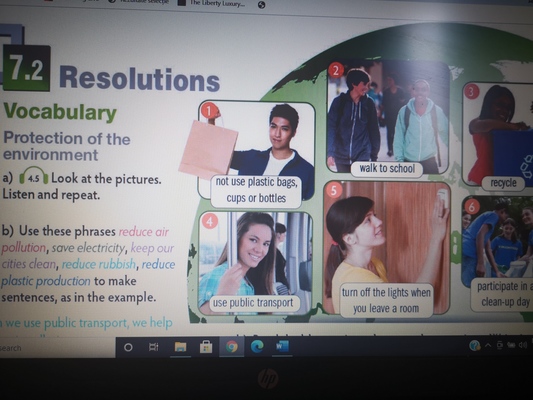
Activity 3: - reading for specific information
Students read a blog entry about 3 teenagers describing their green resolutions for the next year. After reading the text, they decide about who are the given sentences talking about. (Richard, Vanessa or JP)
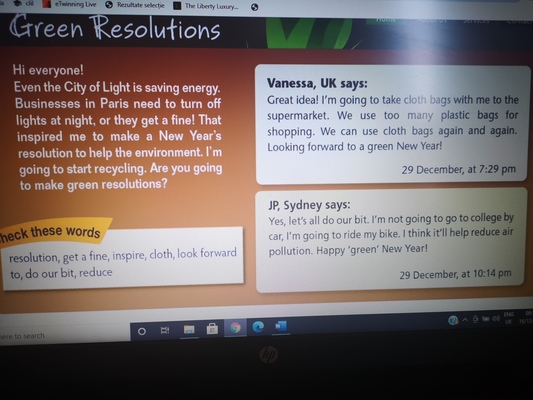
Activity 4: -vocabulary practice
Students complete the short text with missing words: reduce, bit, keep, recycle, cloth
Think Green and 1.).......................the environment clean!
- Ride a bike. It helps 2.) ........................air pollution.
- 3.) .....................paper, glass, plastic.
- Take 4.) ............................bags to the supermarket. Don’t use plastic ones.
We must all do our 5.).....................to help protect the environment.
Activity 5: Listening and vocabulary practice
Students listen to Damien speaking and complete the missing words as they listen.
Green School Resolutions
- Keep the playground 1.)......................
- Buy notebooks from 2.) ........................paper.
- Have more 3.)..........................in the classroom.
- Use household waste to make pieces of 4.) .....................
Activity 6: Whole class discussion
Students talk about their green resolutions for the nexy year.
Textbook: - pages 108-109 https://manuale.edu.ro/manuale/Clasa%20a%20VI-a/Limba%20moderna%20engleza/UNISCANGRUPEDUCA%C8%9AIONAL1/
CLIL Lesson Dec 2020.docx
Vilniaus Sausio 13-osios progimnazija, Lithuania
Civics Education CLIL LT 4.docx
Age of students/Grade: 11-12 years old /5th grade
Level of English: A1
Teacher(s): Žana Šunina
Subject(s): English / Civics Education
Topic: Road Signs
Aims:
Teaching points:
| Language | Content |
- Coach
- To memorise
- Circle
- Triangle
- Rectangular
- Precise
- Warning
- Direction
- Condition
- Motorway
- Recreational
- To watch out
| - Road signs
- Traffic signs
- The importance of road and traffic signs
|
Resources: computers/laptops/tablets/mobile phones, Zoom app, internet connection.
Description of the activities:
Activity 1: To introduce the topic
- T directs Ss to the traffic signs and asks questions: How do you like to travel? How do traffic signs differ? Ss look at the pictures, answer the questions. Ss predict the content of the text.
- T explains/elicits the meanings of any unknown words.
Activity 2: To read for specific information
- Ss read the text individually (ANNEX 1).
Activity 3: To consolidate new vocabulary
Activity 4: To practise research skills, to develop presentation skills
- Ss collect information about traffic signs as their homework.
- Ss present the information next lesson.
Supplementary materials:
“Access” – Student’s book for the 5th grade, Express Publishing, page 95.
https://www.liveworksheets.com/worksheets/en/English_as_a_Second_Language_(ESL)/Colours/Road_Safety_-_Signs_jb15257gq
https://www.liveworksheets.com/worksheets/en/English_as_a_Second_Language_(ESL)/Road_signs/Road_signs_mp802206xq
https://www.liveworksheets.com/worksheets/en/English_as_a_Second_Language_(ESL)/Road_signs/Road_Safety_-_Signs_groups_qm15259ez
ANNEX 1
Read the text.
Road Signs
If you think that you don’t need to pay attention to road signs because you don’t drive a car, think again.They are there for everyone’s safety. So, if you ride a bicycle or even just walk, you need to know what the signs mean.
There are many different signs and it’s hard to memorise all of them, but you should try to remember the most important ones.
Signs with red circles show speed limits and tell you what you mustn’t do, while signs with red triangles give warnings.
Signs with blue circles usually give positive instructions about which direction to follow, while rectangular blue signs give information and directions on motorways and tell us lanes bicycles can use in towns.
Green signs give precise information about directions and distances.
Yellow signs with black letters or symbols give warnings to drive carefully and inform you about the condition of the road.
Orange signs with black letters or symbols inform you that there are road works ahead.
Brown signs give directions to places of historic, cultural or recreational interest.
So next time you’re out and about, watch out for the signs.
ANNEX 2
Answer the questions.
1. Which sign tells you what you mustn’t do?
2. Which sign gives you information about the condition of a road?
3. Which sign tells you how fast you can drive?
4. Which sign shows you which direction to follow?
5. Which sign tells you where there is a museum?
6. Why should you watch out for the signs?
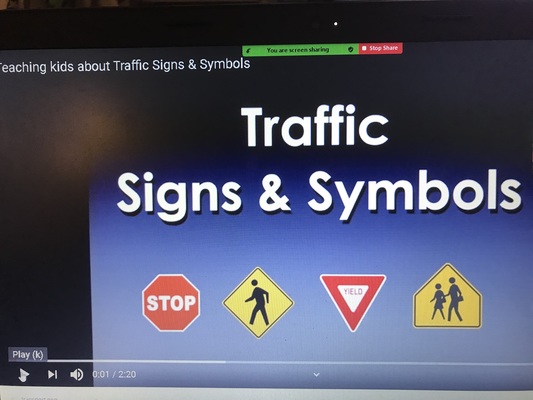
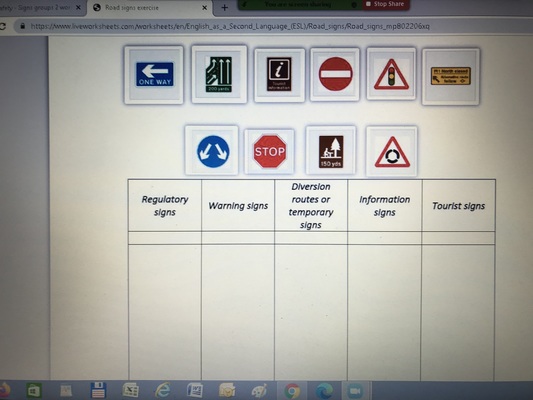
CIVICS EDUCATION CLIL LESSONS 5
March 2021
School: Liceul Tehnologic Octavian Goga Jibou, Romania
Age of students/Grade: 11 years old /5th grade
Level of English: A1
Teacher(s): Nagy Melinda
Subject(s): English / Civics Education
Topic: Netiqutte – How to behave online?
Aim:
-to understand proper behaviour when communicating online.
-to understand how the world deals with acceptable internet use as well as internet etiquette
Teaching points:
| Language | Content |
| netiqutte abbreviation keep in mind to avoid rules of conduct | Online behaviour/Rules of conduct Online communication |
Resources: internet connection, laptop/tablet/smarphone, Google Meet, online textbook
Description of the activities:
Activity 1: Definition, introducing new words
Defining netiquette – whole class discussion
Netiquette is a combination of the words network and etiquette and is defined as a set of rules for acceptable online behavior. Similarly, online ethics focuses on the acceptable use of online resources in an online social environment.
Activity 2: - watching a video
-students watch a video about the do’s and don’t’s of digital etiquette, (netiquette)
https://www.youtube.com/watch?v=W1DjeloLz2U
Activity 3: - whole class discussion based on the video and personal opinion
1. Why are rules of conduct important when communicating online?
2. What rules should keep in mind when online?
3. What are some good things to do in your online communication?
4. What are some things to avoid?
5. What are some useful abbreviations to use in your messages?
6. How can you show emotions in an electronic message?
Activity 4: -poster creation
Students create a poster with 10 netiqutte rules
School: Vilniaus Sausio 13-osios progimnazija, Lithuania
CivicsCLIL_5 LT.docx
Age of students/Grade: 10-11years old /4th grade
Level of English: pre A1/A1
Teacher(s): Žana Šunina
Subject(s): English / Civics Education
Topic: 3Rs: Reduce, Reuse, Recycle
Aims:
Teaching points:
| Language | Content |
- To reduce
- To reuse
- To recycle
- To avoid
- Waste
- Tornado
- Hurricane
- Flood
- To turn on (off)
- Global warming
| |
Resources: video projector, laptop, speakers
Description of the activities:
Activity 1: To introduce the topic and new vocabulary
- T directs Ss to the pictures and asks questions: ‘’How do we help the Earth?’’, ‘’What can we recycle?’’ Ss look at the pictures, answer the questions. Ss predict the content of the text.
- T explains/elicits the meanings of any unknown words.
Activity 2: To read for detailed understanding
- Ss read the text aloud (ANNEX 1).
- T checks the understanding of the text by asking questions: What are unwelcome events in the world? What do ‘’3Rs’’ stand for? What can you do to protect the Earth?
Activity 3: To watch a video and consolidate information
https://www.youtube.com/watch?v=OasbYWF4_S8
- T asks Ss to work in pairs and name the things they can reduce, reuse or recycle.
- Ss report their ideas back to the class.
Activity 4: To make a poster ‘’3Rs’’.
Supplementary materials:
“Early School English 3: Yummy English”– textbook for the 4th grade. N. Sabeckienė, V. Rupainienė, V. Maskvytienė, ,,Šviesa’’.
ANNEX 1
Read.
3Rs (Reduce, Reuse, Recycle)
Every year we watch more and more unwelcome events in the world. Tornadoes, Hurricanes, floods... This is because of global warming. Everyone can protect the planet Earth. What can you do? This is the answer!
REDUCE
Use less... buy less... avoid waste...turn off lights... take shorter showers...
REUSE
Use things more than one time... use cloth shopping bags... fix things...
RECYCLE
Recycle products! Recycling one ton of paper saves seventeen trees. It is clear for everyone – me and you, him and her, us and them – why to reduce, reuse and recycle. Help our Earth stay nice and clear! Help our Earth stay strong and green!
